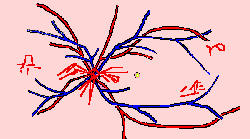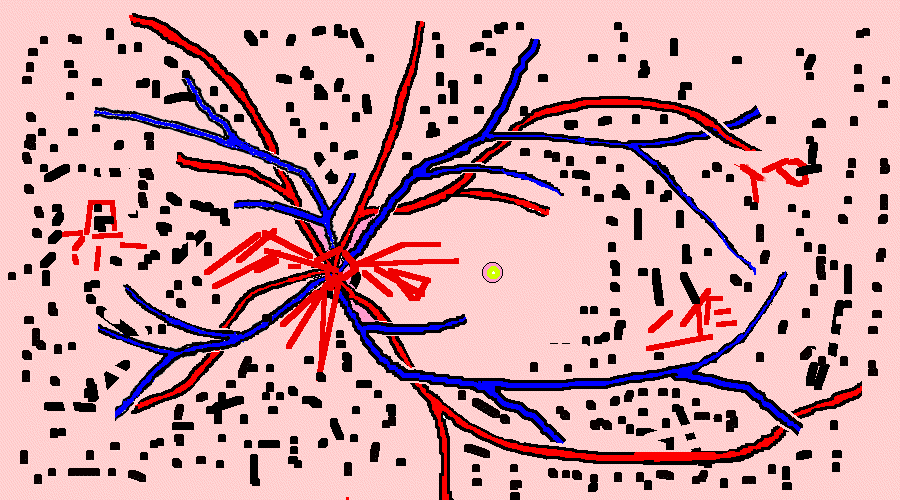|
| |
Proliferative Retinopathy
| In this condition very small blood vessels
(capillaries) grow on the surface of the retina. (The retina is the film at the back of
your eye: see MECHANISMS.) If someone has had diabetes for years the retina may become damaged,
and release special growth chemicals. These chemicals make other tiny blood vessels
grow: these are called 'new blood vessels'.
These new blood vessels are unusual because they are very weak and
can bleed very easily. This blood stays in the eye and can, after a while, cause very
serious eye problems.
Usually in this condition, without laser treatment, the sight is
very badly affected and people may become blind. |
 In proliferative
retinopathy 'new blood vessels' grow on the surface of the retina and can bleed. This
process is shown in the animation (exaggerated).
This side view of an eye is explained in
'Retinopathy, Mechanisms' |
| The new vessel growth only occurs in the retina,
nowhere else in the body. When a retina becomes damaged by a higher than normal sugar,
over many years, it seems to release special growth hormones. (This process is not
completely understood, but what is known is summarised here.) VEGF
is one of the main growth hormones; VEGF stands for Vascular Endothelial Cell Growth
Factor. It seems to be manufactured and released by 'sick' retinal capillaries, and in
turn makes other capillaries grow. This seems to be an exaggeration of one of the body's
normal responses.... the retina becomes starved of nutrients, and then the retina makes
chemicals that make new blood vessels grow to deliver more nutrients.
There are other growth factors and processes involved (Mechanisms); readers may wish to read Abstracts
and Research.
Drugs are being tried out that block VEGF and stop it working, but
we await the results. In the meantime, only laser will treat this condition.
We believe laser works as the tiny laser burns allow more oxygen and
nutrients to reach the retina, thus improving retinal function. The retina then stops
making the growth substances, and the 'new vessels' close up as a result.
Deterioration may be rapid if the control of your diabetes suddenly
improves: see unexpected deterioration on the pre-proliferative
page. |

New blood vessels growing on the
retinal surface and slightly in front of the surface. This picture exaggerates slightly.
diabetes for years
^
retinal damage
^
retina releases growth chemicals
^
'new vessels' grow
^
laser burns
^
oxygen and nutrient flow to retina improves
^
new vessels close up
^
more new vessels grow
^
more laser needed
^
new vessels close up
^
and so on
until
eventually they stop growing
a description of events in
proliferative retinopathy (start at top) with laser treatment |
Laser Treatment
| Laser is the only way of treating this
condition. With laser the new vessels will usually stop growing, although sometimes
several laser sessions are needed. The new vessels do usually
close up, but may start growing again 4-8 months later, and requiring more laser.
1000 or so laser shots are applied at each visit (see Laser Treatment), but in the average insulin-dependant person 3000 or
more shots may be needed at the onset (3 sessions), with more laser of 2000 burns a little
later, and more now and again.
|

Laser burns for proliferative
retinopathy. (They appear white, but are shown black here for illustration.) |
Severe proliferative retinopathy
In people with the severest type of
proliferative retinopathy, a lot of laser is needed over the years. As a result, a
person's side vision and night vision may be badly affected.
Often the best that can be achieved is maintaining good (perhaps not perfect) central
vision, enabling a person to work, watch TV, and read.
Many people with retinopathy like this who have had such laser do keep working, and many
can drive in the daytime.
Eventually after very extensive laser as shown opposite, the new vessels do stop growing
and the condition stabilises. There is then very little deterioration after this, if any.
Ophthalmologists thus try to be very positive when treating this type of retinopathy, as
very few people with it would become blind, and most people keep good, albeit not perfect,
sight. |

Extensive laser is needed for some
people with proliferative retinopathy |
|